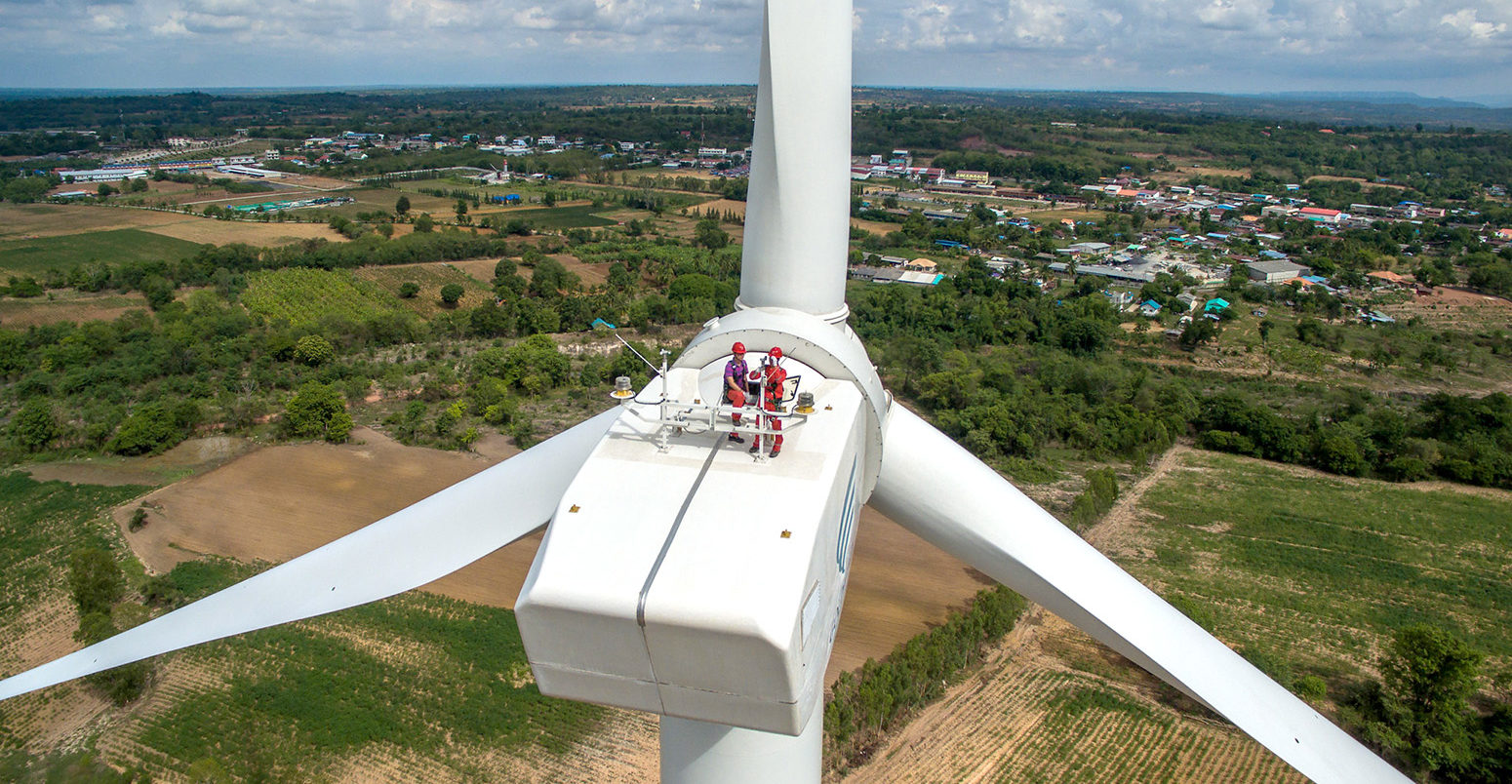
IEA: Low-carbon spending must ‘more than double’ to meet climate goals
Josh Gabbatiss
05.14.19Josh Gabbatiss
14.05.2019 | 4:39pmInvestment in low-carbon energy sources, such as wind, solar and nuclear, must more than double by 2030 if the world is to meet its Paris Agreement climate goals, according to the International Energy Agency (IEA).
This is one of the many insights to emerge from the agency’s latest World Energy Investment report, which is published today. Besides the trend in low-carbon spending, the analysis shows that overall energy investment is also not keeping up with consumption trends. [Carbon Brief also covered the IEA’s reports in 2017 and 2018.]
Here, Carbon Brief has picked out key charts to illustrate these trends, as well as some of the IEA’s findings on everything from electric car sales to the spread of air conditioning units and battery storage.
Missing sustainability targets
Overall, the research found that global investment in all forms of energy supply and demand stabilised in 2018 at around $1.85tn, after three years of decline. Within that total, investment in low-carbon energy was also stable at around $620bn, as the chart below shows.
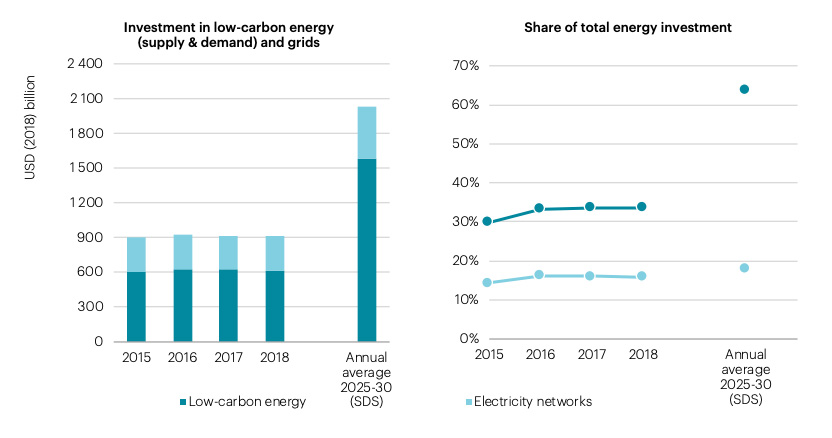
Global investment in low-carbon energy and electricity networks needs to rise significantly if the world is to meet the IEA’s sustainability benchmark, known as the Sustainable Development Scenario. In this chart, low-carbon energy investment includes energy efficiency, renewable power, renewables for transport and heat, nuclear, battery storage and carbon capture utilisation and storage. Source: IEA.
Over the past year, spending on renewables for transport and heat fell slightly, while nuclear and energy efficiency expenditures remained roughly the same. Investment in electricity grids, which are vital for a clean energy transition, has been falling for the past two years.
The IEA suggests this stagnation is a cause for concern if the world is to live up to the sustainable scenarios it has laid out. The agency has developed its Sustainable Development Scenario (SDS) as a benchmark for measuring progress towards a future in which the Paris Agreement targets are met and air pollution is slashed.
As it stands, low-carbon investment will have to increase two-and-a-half times by 2030 to meet this goal (chart on the left, above). Its share of total spending would have to rise from 35% to 65% (above right).
IEA energy investment analyst Michael Waldron noted in a press briefing ahead of the report’s release that, overall, energy investment is not high enough to satisfy either the SDS or the New Policies Scenario (NPS), which would see warming reach around 2.5C by 2100:
“It’s clear that 2018 energy supply investment is not enough to meet the goals in either of those scenarios, it’s about 15% lower than the levels in the NPS and about 20% than that required in the SPS, so in any scenario that we can see… energy supply investment would need to increase.”
This point was echoed by Dr Fatih Birol, executive director at the IEA, who said in a press release that energy investments now face “unprecedented uncertainties”:
“The bottom line is that the world is not investing enough in traditional elements of supply to maintain today’s consumption patterns, nor is it investing enough in cleaner energy technologies to change course. Whichever way you look, we are storing up risks for the future.”
Fossil-fuel spending
While the IEA future scenarios suggest total energy-supply investment will need to increase significantly, the amount will vary considerably for different sectors.
For coal, the IEA found current spending “comfortably exceeds” the levels required by the late 2020s, as the chart below left shows. It says gas-fired power is still a key part of the energy mix in both its future scenarios, but to achieve climate goals a “swift phase-out” will be required for new coal plants without technology in place to remove their CO2 emissions.
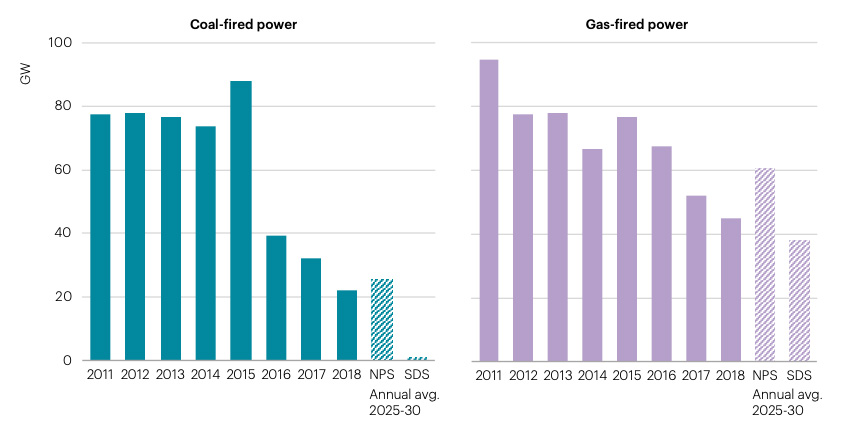
Investment in coal- and gas-fired power generation in recent years, compared with the future scenarios laid out by the IEA for its New Policies Scenario and its Sustainable Development Scenario (shown as annual average needs 2025-30). While in a sustainable future, gas remains very much a part of energy investment, coal must drop considerably. Source: IEA
The IEA’s conclusions support comments made by UN secretary-general Antonio Guterres in a recent interview, in which he called on nations to build no new coal-power plants after 2020.
While the number of new coal projects has fallen in recent years, large developing economies are still planning on a pipeline of new plants to support their growth. Nevertheless, the number of new decisions to begin construction of coal plants declined by nearly a third last year, the IEA says, with a particularly large drop in China. The Chinese government has made an effort to restrict new coal developments due to air pollution concerns and signs of overcapacity.
US dominates fossil fuel investment
One dollar out of every 10 invested around the world into energy goes towards financing oil and gas in North America, the IEA says. While more money is invested in Chinese energy overall, the US spends far more on fossil-fuel supply than any other nation, as the chart below shows. This spending far surpasses even that in the Middle East, Europe or Russia.
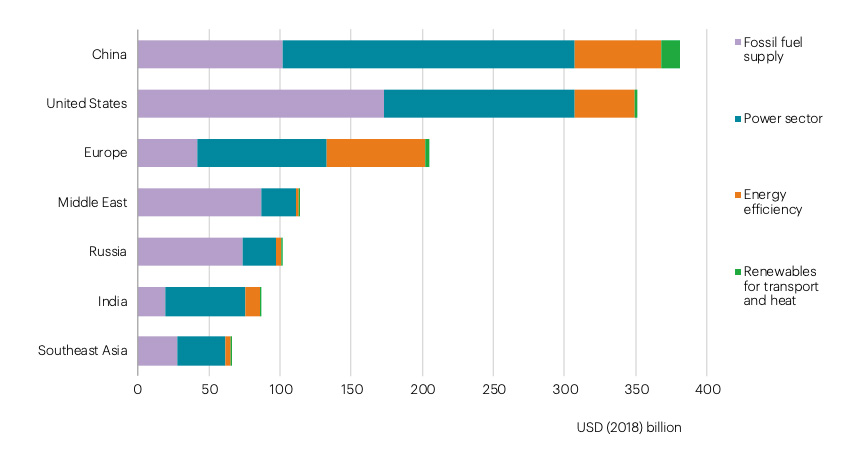
In this chart showing total energy investment for 2018, the US emerges as spending far more on fossil fuel supply than any other nation. Source: IEA
Last year, a boost in US spending on oil-and-gas supply was attributed to the nation’s thriving shale industry, which stretches from Pennsylvania to Texas, and this trend appears to be continuing, the IEA says. Overall, the US has driven most of the growth in energy-supply investment over the past decade.
Meanwhile, investment in exploration for new oil-and-gas reserves continues to fall, and actually reached record lows in 2018. Spending in the sector almost halved between 2014 and 2018, due in part to the collapse of oil prices and, as a result, the discovery of new oil reserves fell by around two-thirds compared to the average over the previous decade.
However, despite its dramatic decline in recent years, the IEA predicts this industry is set to stage a comeback, with investment expected to increase by 18% in 2019. The report says signs of this are already emerging as offshore reserves have recently been found from Cyprus to Guyana.
Cheaper renewables
While an initial glance at investment in renewable power suggests the world’s spending on wind, solar and hydro is stalling (chart, below left), this partly reflects the plummeting costs of these technologies. In a trend also playing out for oil and gas, a dollar spent on renewable energy now buys significantly more than it did in the past, as the chart on the right shows.
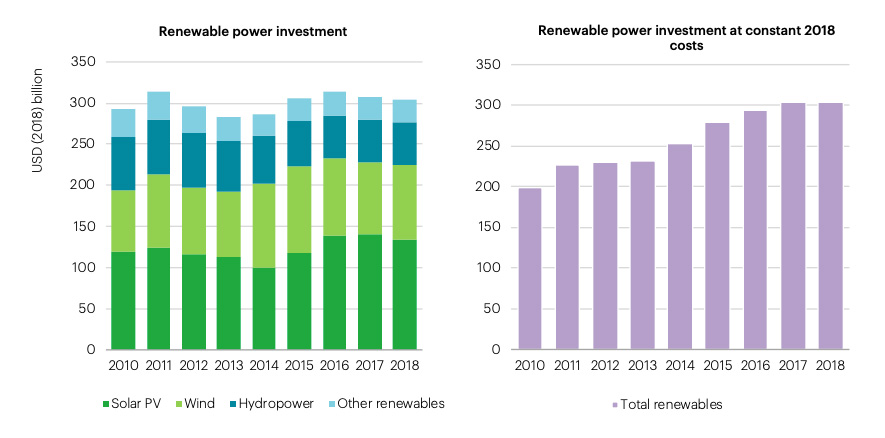
Two charts showing actual investment in renewable power (left) versus spending when the falling cost of renewables is taken into consideration (right). Source: IEA.
Once falling costs have been adjusted for, the IEA’s figures show a slight increase in renewable investment every year this decade and a 55% rise since 2010.
Each gigawatt (GW) of renewable capacity is also getting faster to build, which could reflect a shift from wind towards solar installations with shorter construction times.
Nevertheless, the agency has warned that the sluggish growth of renewables risks compromising the world’s long-term climate goals. Earlier in May, it said that following two decades of strong growth, the capacity of renewables added in 2018 was no larger than it was in 2017. [Others suggest there was a small increase.]
To remain in line with the SDS, the IEA says renewable capacity must increase by 300GW every year, on average, between 2018 and 2030. In 2018, just 180GW was added.
Responding to this news, Birol stated in a release that the world “cannot afford to press ‘pause’ on the expansion of renewables”. He called for stable policies that would allow the burgeoning technologies to flourish.
Electric cars surge
Continuing a trend that Carbon Brief reported after last year’s IEA report was released, electric car sales are increasing rapidly, as the chart below shows. Global sales approached two million in 2018, up by nearly 70% from just over one million last year.
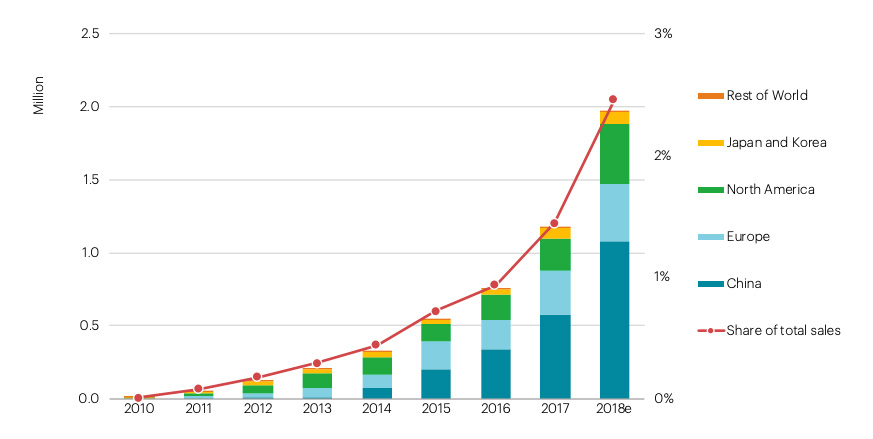
Electric passenger “light duty vehicle” sales and market share, with breakdown by region. This includes both cars and light trucks, and takes into account plug-in hybrids, battery electric vehicles and fuel cell electric vehicles. Source: IEA Global Electric Vehicle Outlook 2019.
After the strongest year of growth for several years, the overall stock of electric vehicles stood at more than five million at the end of 2018. The IEA reported that the global fleet only exceeded one million as recently as 2015.
The upward trend last year was once again largely driven by a single nation – China – as the report explains:
“Over 1.1 million electric cars were sold in 2018, similar to the total number of all cars sold in Mexico that year, and comfortably surpassing all the new cars registered in Africa. While electric car sales increased, overall passenger vehicle sales in China declined in 2018.”
In the same period, 385,000 electric cars were sold in the whole of Europe, the IEA notes, with Norway’s sales now comprising 50% electric models. The US followed closely behind with 360,000 units sold last year. The IEA has previous stated that the production capacity of lithium and cobalt will need to expand rapidly to cope with demand for electric vehicle batteries as they continue their upward trajectory.
Investing in electric
The success of electric vehicles was matched by the enthusiasm on display from venture capital investors last year. Their investment in clean energy overall reached record levels of $6.9bn last year, with transport the largest sector by far.
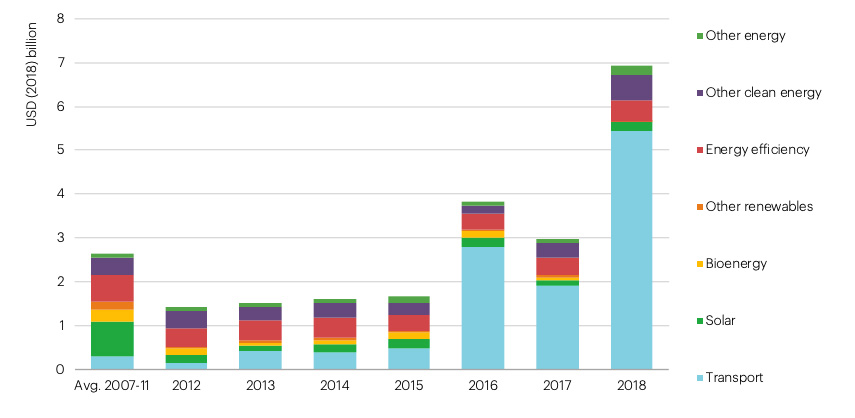
Chart showing global venture capital investment in energy technology companies, with transport (including powertrains and fuel economy, but not shared mobility, logistics or autonomous vehicle technology) emerging as the most popular sector. Source: IEA.
Startups based in China, with its burgeoning electric-vehicle industry, overtook the US for attracting venture capital to early-stage energy technologies, the IEA says, taking more than half the deal value.
Other popular investment sectors were energy storage, hydrogen and fuel cells, as well as fossil-fuel extraction and conversion.
Note that venture capital only make a small share of total investments in clean energy.
Battery rollout continues
Overall, investment in battery storage reached its highest level ever in 2018, the IEA reports, hitting $4bn after rising by 45%. Money was poured both into batteries servicing national grids (chart, below left) and those that are connected to private electrical infrastructures “behind-the-meter” (below right).
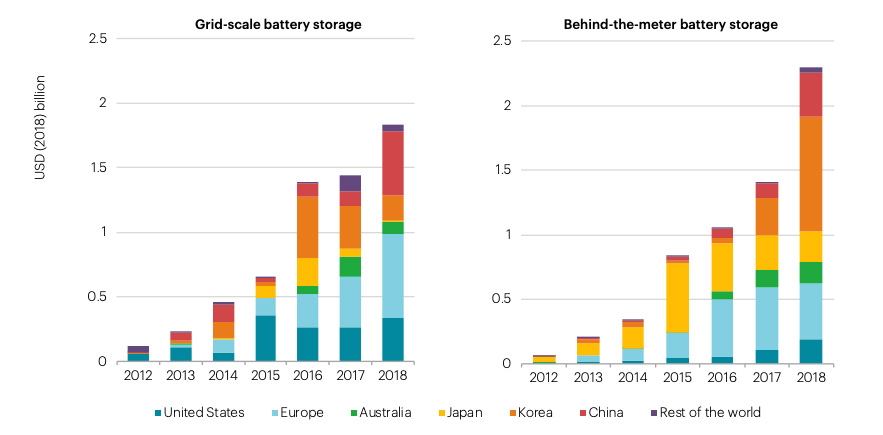
Investment in stationary battery storage increased, both for batteries servicing national grids and those connected to private electrical infrastructure. Source: IEA analysis with calculations based on Clean Horizon (2019), China Energy Storage Alliance (2019) and BNEF (2019).
The price tag attached to these projects saw significant declines, with the cost of battery storage, primarily lithium batteries, dropping by 50%.
European deployment of grid-scale battery storage, particularly in the UK, combined with the US to make up half of all 2018 investment. Meanwhile, China saw the largest growth in the sector, with spending increasing by 30%. Behind-the-meter investment, led by Korea, rose by 60% last year.
As with many other sectors, the IEA concluded that investment in battery storage alongside electricity networks still needs a considerable boost if the world is to meet its climate targets.
Air conditioner sales heat up
Sales of air conditioners saw a record annual increase of 16% last year, a trend the IEA says was driven in part by the extreme weather and heatwaves that scorched the planet from California to Japan last year.
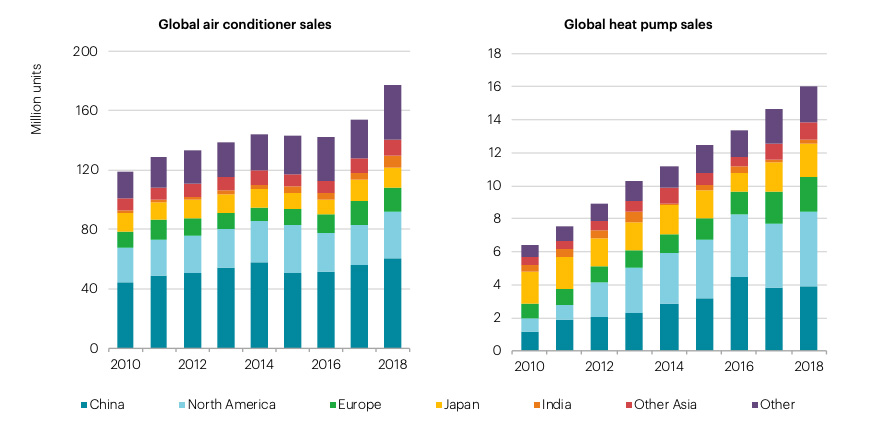
Global sales of electrical air conditioner units and heat pumps both increased in 2018. Heat pump sales are those for primary use in heating, and include air-to-air and air-to-water heat pumps. Source: IEA analysis with calculations partly based on BSRIA (2018) and company and industry association disclosures.
The IEA notes that this growth – which is driven by North America, India, Brazil, the Middle East and China – comes at a considerable cost. CO2 emissions from cooling have tripled since 1990, making them equivalent to the total emissions of Japan.
As both temperatures and average incomes rise this century, a vicious cycle of air conditioning is expected to set in as demand for air conditioning rises to cope with global warming, the IEA warns, which in turn exacerbates the problem.
While sales of heat pumps were an order of magnitude lower than air conditioners, their sales also saw growth. Europe was the largest market, with heat pumps boosted by their eligibility to contribute towards EU renewable energy targets.
-
IEA: Low-carbon spending must ‘more than double’ to meet climate goals
-
Low-carbon spending must ‘more than double’ to meet climate goals, says IEA

